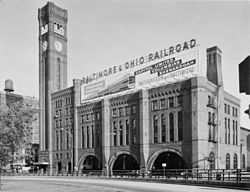Grand Central Station (Chicago)
|
Grand Central Passenger Station
|
|
|
Formerly listed on the U.S. National Register of Historic Places
|
|
 |
|
| Built | 1890 |
|---|---|
| Demolished | 1971 |
| NRHP Reference # | 71001084 |
| Significant dates | |
| Added to NRHP | Unknown |
| Removed from NRHP | 1971 |
Grand Central Station was a passenger railroad terminal in downtown Chicago, Illinois, from 1890 to 1969. It was located at 201 West Harrison Street on a block bounded by Harrison, Wells and Polk Streets and the Chicago River in the southwestern portion of the Chicago Loop. Grand Central Station was designed by architect Solon Spencer Beman for the Wisconsin Central Railroad (WC), and was completed by the Chicago and Northern Pacific Railroad.
The Baltimore and Ohio Railroad purchased the station in 1910 and used it as the Chicago terminus for its passenger rail service, including its Capitol Limited service to Washington, D.C. Major tenant railroads included the Soo Line Railroad, successor to the Wisconsin Central, the Chicago Great Western Railway, and the Pere Marquette Railway. The station opened December 8, 1890, closed November 8, 1969, and was demolished in 1971.
In October 1889, a subsidiary of the Wisconsin Central Railroad began constructing a new passenger terminal at the southwest corner of Harrison and Wells Streets (then called Fifth Avenue) in Chicago, to replace a nearby temporary facility. The location of this new depot, along the south branch of the Chicago River, was selected to take advantage of the bustling passenger and freight market traveling on nearby Lake Michigan.
Architect Solon S. Beman, who had gained notoriety as the designer of the Pullman company neighborhood, designed the station in the Norman Castellated and chose brick, brownstone and granite for construction. The structure measured 228 ft (69 m) along Harrison Street and 482 ft (147 m) along Wells. Imposing arches, crenellations, a spacious arched carriage-court facing Harrison Street, and a multitude of towers dominated the walls. Its most famous feature, however, was an impressive 247 ft (75 m) tower at the northeast corner of the structure. Beman, an early advocate of the Floating raft system to solve Chicago's unique swampy soil problems, designed the tower to sit within a floating foundation supported by 55 ft (17 m) deep piles. Early on, an 11,000 lb (5,000 kg) bell in the tower rang on the hour. At some point, however, the bell was removed, but the tower (and its huge clock, 13 ft (4.0 m) in diameter—at one time among the largest in the United States, remained.
...
Wikipedia
